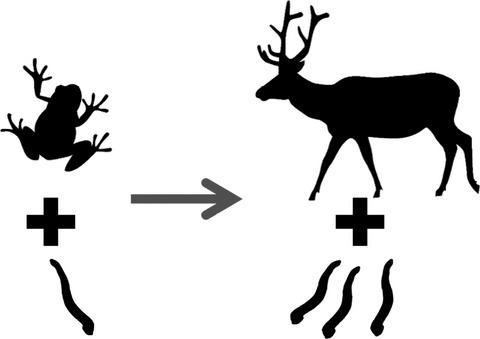当前位置:
X-MOL 学术
›
Ecol. Evol.
›
论文详情
Our official English website, www.x-mol.net, welcomes your feedback! (Note: you will need to create a separate account there.)
Sika deer presence affects the host-parasite interface of a Japanese land leech.
Ecology and Evolution ( IF 2.6 ) Pub Date : 2020-05-19 , DOI: 10.1002/ece3.6344 Kaori Morishima 1 , Takafumi Nakano 2 , Mineaki Aizawa 3
Ecology and Evolution ( IF 2.6 ) Pub Date : 2020-05-19 , DOI: 10.1002/ece3.6344 Kaori Morishima 1 , Takafumi Nakano 2 , Mineaki Aizawa 3
Affiliation

|
Since the 1990s, increasing populations of a blood feeding land leech (Haemadipsa japonica ) have become a serious issue in several Japanese prefectures, and it may be caused by the increases in sika deer (Cervus nippon ) populations seen over the last quarter of the century. Therefore, this study aimed to reveal the host animal species of H . japonica using iDNA (vertebrate DNA isolated from invertebrates) and to test the hypothesis that the increasingly widespread distribution of sika deer results in increased H . japonica populations through changes to the host–parasite interface. We amplified mitochondrial DNA 16S ribosome RNA fragments from iDNA isolated from the blood clots of H . japonica collected across Japan. We identified 17 host animal species, including four orders of Mammalia (Carnivora, Artiodactyla, Rodentia, and Lagomorpha) and two orders of Amphibia (Caudata and Anura). The sika deer was the dominant host species of H . japonica . Additionally, the host animal species composition of H . japonica differed according to the presence or absence of sika deer. In the sites where sika deer were not found, Anura (frog) species were the most commonly identified hosts of H . japonica . These results suggest that the increases in H . japonica populations might have occurred via a change in host preference to sika deer. This change might be driven by the increases in sika deer populations and subsequent increase in the frequency that H . japonica uses the sika deer as easy prey, as well as by sika deer providing more reproductive energy per blood meal than blood meal from frog species. The present study suggests that a more widespread distribution of sika deer resulted in an increase in H . japonica through a change in the host–parasite interface. Therefore, management that focuses on decreasing sika deer populations would likely be an effective method for the reduction of H . japonica populations.
中文翻译:

梅花鹿的存在会影响日本陆栖水蛭的宿主-寄生虫界面。
自20世纪90年代以来,吸血水蛭(Haemadipsa japonica )数量的增加已成为日本几个县的一个严重问题,这可能是由于本世纪最后四分之一世纪梅花鹿(Cervus nippon )数量的增加造成的。因此,本研究旨在揭示H的宿主动物种类。使用 iDNA(从无脊椎动物中分离出的脊椎动物 DNA)对japonica进行研究,并检验梅花鹿分布日益广泛导致H增加的假设。通过改变宿主-寄生虫界面来改变粳稻种群。我们从幽门螺杆菌血凝块中分离出的 iDNA 中扩增了线粒体 DNA 16S 核糖体 RNA 片段。日本各地采集的粳稻。我们鉴定了 17 种宿主动物物种,包括哺乳纲 4 目(食肉目、偶蹄目、啮齿目和兔形目)和两栖纲(有尾目和无尾目)。梅花鹿是梅花鹿的优势宿主物种。粳稻。此外, H的宿主动物物种组成。粳稻根据梅花鹿的有无而有所不同。在没有发现梅花鹿的地区,无尾蛙(Anura)物种是最常见的梅花鹿宿主。粳稻。这些结果表明H的增加。粳稻种群的发生可能是由于寄主对梅花鹿的偏好发生了变化。这种变化可能是由梅花鹿数量的增加以及随后H的频率增加所驱动的。粳稻将梅花鹿作为容易捕获的猎物,并且梅花鹿每次血粉提供的生殖能量比青蛙物种的血粉更多。目前的研究表明,梅花鹿的更广泛分布导致了H的增加。粳稻通过宿主-寄生虫界面的变化。因此,以减少梅花鹿数量为重点的管理可能是减少梅花鹿的有效方法。粳稻种群。
更新日期:2020-06-26
中文翻译:

梅花鹿的存在会影响日本陆栖水蛭的宿主-寄生虫界面。
自20世纪90年代以来,吸血水蛭(Haemadipsa japonica )数量的增加已成为日本几个县的一个严重问题,这可能是由于本世纪最后四分之一世纪梅花鹿(Cervus nippon )数量的增加造成的。因此,本研究旨在揭示H的宿主动物种类。使用 iDNA(从无脊椎动物中分离出的脊椎动物 DNA)对japonica进行研究,并检验梅花鹿分布日益广泛导致H增加的假设。通过改变宿主-寄生虫界面来改变粳稻种群。我们从幽门螺杆菌血凝块中分离出的 iDNA 中扩增了线粒体 DNA 16S 核糖体 RNA 片段。日本各地采集的粳稻。我们鉴定了 17 种宿主动物物种,包括哺乳纲 4 目(食肉目、偶蹄目、啮齿目和兔形目)和两栖纲(有尾目和无尾目)。梅花鹿是梅花鹿的优势宿主物种。粳稻。此外, H的宿主动物物种组成。粳稻根据梅花鹿的有无而有所不同。在没有发现梅花鹿的地区,无尾蛙(Anura)物种是最常见的梅花鹿宿主。粳稻。这些结果表明H的增加。粳稻种群的发生可能是由于寄主对梅花鹿的偏好发生了变化。这种变化可能是由梅花鹿数量的增加以及随后H的频率增加所驱动的。粳稻将梅花鹿作为容易捕获的猎物,并且梅花鹿每次血粉提供的生殖能量比青蛙物种的血粉更多。目前的研究表明,梅花鹿的更广泛分布导致了H的增加。粳稻通过宿主-寄生虫界面的变化。因此,以减少梅花鹿数量为重点的管理可能是减少梅花鹿的有效方法。粳稻种群。



























 京公网安备 11010802027423号
京公网安备 11010802027423号